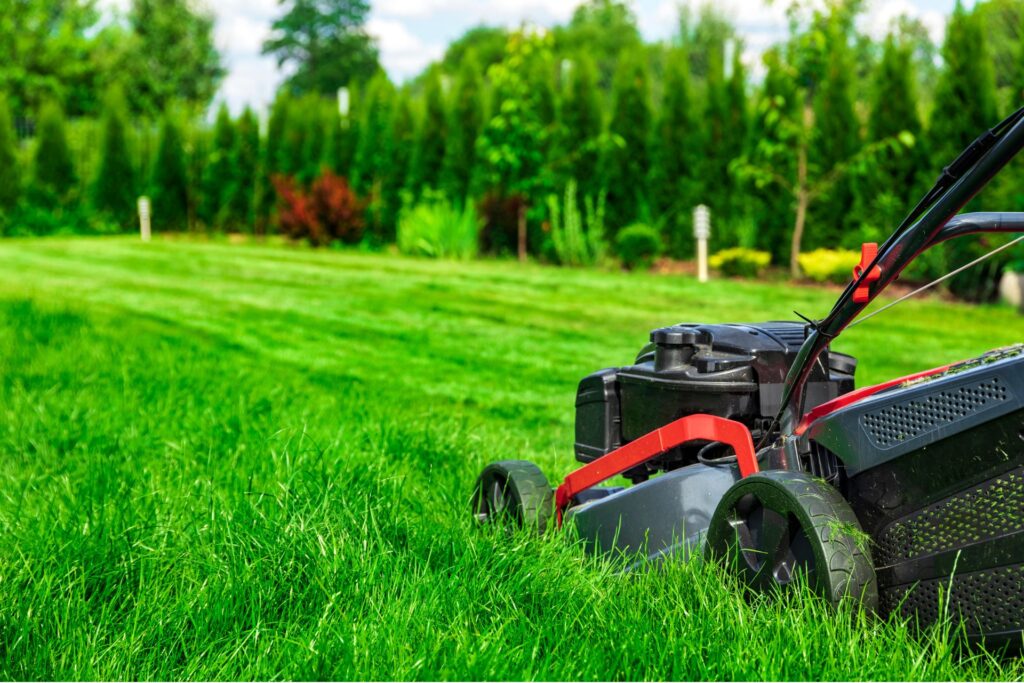Welcome to the vibrant world of terrace gardening in New Zealand! Whether you’re a seasoned green thumb or just starting to explore the joys of planting, creating a lush garden on your terrace is a fantastic way to bring a bit of nature into your urban space. In this blog, we’ll delve into selecting the perfect plants that not only thrive in New Zealand’s unique climate but also enhance your outdoor living area. Our aim is to equip you with all the knowledge you need to pick the right greenery for your space, ensuring your terrace garden blooms beautifully throughout the year. Get ready to transform your terrace into a stunning, serene oasis!
If you’re planning a terrace garden in New Zealand, choosing plants that thrive in the local climate is crucial. For a vibrant, low-maintenance garden, consider these top picks: Herbs like parsley, chives, and mint are perfect for their easy care and culinary uses; Flowers such as resilient petunias, marigolds, and geraniums bloom beautifully and require minimal upkeep; Vegetables like tomatoes, lettuce, and peppers are ideal for container gardening; Fruits such as compact strawberries and dwarf citrus trees offer fresh flavors right from your balcony; and Native Plants like Hebe and Pohutukawa add a truly Kiwi touch to your garden. These selections not only enhance the aesthetic of your terrace but also ensure a thriving garden suited to New Zealand’s diverse environments.
- Understanding New Zealand’s Climate And Its Impact On Terrace Gardening
- Benefits Of Having A Terrace Garden In New Zealand
- Key Considerations Before Planting
- The Best Plants For A Terrace Garden In New Zealand
- Design Tips For Maximizing Space In Your Terrace Garden
- Seasonal Care And Maintenance Tips For Your Garden
- Common Challenges And Solutions In Terrace Gardening
- Inspirational Case Studies
- FAQs: About Best Plants For Terrace Garden NZ
- Conclusion
- Find A Landscaping Company Near You
Understanding New Zealand’s Climate And Its Impact On Terrace Gardening
New Zealand’s unique geographical features shape a distinctly varied climate that greatly influences terrace gardening across the country. In this article, we delve into how the diverse climatic zones of New Zealand, particularly the differences between the North and South Islands, impact gardening practices and the importance of selecting the right plants suited to these environments.
The Climate Diversity of New Zealand’s Islands
New Zealand is split into two main islands, each with its own climate characteristics that are essential to understand for any gardener:
North Island Climate: The North Island of New Zealand enjoys a generally subtropical climate in the far north to temperate conditions in the south. This island experiences warmer temperatures year-round, with mild winters and warm, humid summers. Rainfall is evenly distributed throughout the year, although the northern regions can receive more frequent rain. The warmth and humidity of the North Island make it ideal for growing a wide range of vegetables, fruits, and flowers that thrive in these conditions.
South Island Climate: In contrast, the South Island features a more varied climate, ranging from oceanic in the north and south to a continental climate in the interior. The temperatures here can be cooler, with colder winters, including frost and snow, particularly in the highlands and southern regions. Summers can be warm but not as humid as in the North Island. Gardening in the South Island can be challenging due to these fluctuations, and selecting frost-resistant and hardy plants is crucial.
Selecting Climate-Appropriate Plants for Successful Gardening
The success of terrace gardening in New Zealand largely depends on choosing plants that are suitable for the local climate. Here’s why plant selection is critical:
Adaptation to Local Conditions: Plants that are well-suited to the local climate conditions will thrive better. In the warmer, humid conditions of the North Island, gardeners can cultivate a range of lush, tropical plants and vegetables such as citrus fruits, avocados, and tomatoes. Conversely, in the cooler South Island, it’s advisable to opt for plants that can withstand frost and cooler temperatures, like root vegetables, certain berries, and hardy greens such as kale and spinach.
Water Requirements: Understanding the rainfall patterns in your area can help in selecting plants with matching water needs. In areas with less frequent rainfall, drought-resistant plants might be necessary, while in wetter regions, plants that can handle soggy soils might be more appropriate.
Sunlight and Wind Exposure: The amount of sunlight and the exposure to wind are also crucial factors. Some plants require full sun, whereas others thrive in partial shade. Similarly, areas exposed to strong winds may need wind-resistant plants or protective measures such as windbreaks to shield more delicate species.
By understanding New Zealand’s diverse climates and carefully selecting plants that are adapted to these environments, terrace gardeners can ensure a thriving garden that enhances their home and provides a fruitful yield. Whether you’re a novice looking to start your first garden or a seasoned green thumb adapting to New Zealand’s conditions, taking these factors into account will lead to greater gardening success.

Benefits Of Having A Terrace Garden In New Zealand
Terrace gardens have become an increasingly popular option for homeowners and city dwellers in New Zealand, offering a blend of aesthetic, environmental, and personal advantages. By transforming your rooftop or balcony into a green oasis, you not only enhance the beauty of your home but also contribute positively to your environment and well-being. Here’s a detailed exploration of the benefits of having a terrace garden in New Zealand.
Environmental Benefits
Improving Air Quality: One of the most significant environmental benefits of terrace gardens is their ability to improve air quality. Plants naturally filter pollutants and carbon dioxide out of the air, replacing them with oxygen. In urban areas of New Zealand, such as Auckland and Wellington, where vehicle emissions and industrial activities can compromise air quality, terrace gardens offer a natural purifying system, helping to decrease the overall concentration of harmful pollutants.
Reducing Urban Heat: Cities are known for the ‘urban heat island’ effect, where urban regions become significantly warmer than their rural surroundings. This is due to the extensive use of asphalt, concrete, and other materials that absorb and retain heat. Plants in terrace gardens help reduce this effect by covering these surfaces and providing shade. Additionally, the process of evapotranspiration, where plants release water vapor, also helps in cooling the air around them.
Personal Benefits
Enhancing Aesthetic Appeal: A terrace garden can transform a bland and often unused space into a vibrant and lively area. For many New Zealanders, the visual appeal of lush greenery and colorful flowers against cityscapes or the more subdued tones of their neighborhoods can significantly enhance the enjoyment and curb appeal of their property. It offers a scenic view that not only pleases the eye but also increases the value of the property.
Providing a Space for Relaxation: In the fast-paced life of today, having a personal retreat can be incredibly valuable. A terrace garden provides a unique escape from the stresses of daily life, offering a tranquil space to unwind, meditate, or enjoy leisure activities surrounded by nature. For many, this space becomes a sanctuary where they can reconnect with nature without leaving their home.
Potential for Organic Produce: For those interested in sustainability and self-sufficiency, terrace gardens provide an excellent opportunity to grow organic produce. Whether it’s herbs, vegetables, or fruits, having direct access to fresh, chemical-free produce right from your balcony or rooftop is not only convenient but also healthier. This aspect is particularly appealing in New Zealand, where there’s a growing interest in organic gardening and farm-to-table cooking.
The adoption of terrace gardens in New Zealand offers a multitude of benefits ranging from environmental improvements to personal wellness. By integrating green spaces into urban settings, residents can enjoy fresher air, cooler environments, and a personal oasis for relaxation and organic farming. As urban areas continue to expand, the role of terrace gardens as vital components of sustainable living becomes more significant. Whether you’re in a bustling city center or a quiet suburban area, the addition of a terrace garden is a step towards a healthier and more sustainable lifestyle.

Key Considerations Before Planting
Embarking on the journey of creating a terrace garden can be exhilarating yet challenging. Before you begin planting, there are several crucial factors to consider to ensure your garden thrives. Here’s a detailed guide to help you prepare effectively.
Assessing Sunlight Exposure on Your Terrace
Sunlight is the lifeblood of any garden, and understanding the amount of sunlight your terrace receives is paramount. Most vegetables and flowers require at least six hours of direct sunlight per day. To assess your terrace’s sunlight exposure, observe the area at different times throughout the day. Note where and when the sun hits the space. This will help you decide which plants are best suited for your garden based on their light requirements.
Understanding Soil Types and Drainage Essentials
Soil is another critical component of gardening. Not all soil types are equal, and the right type can make a significant difference in plant health and growth. For terrace gardens, it’s advisable to use a lightweight potting mix that provides excellent drainage. Avoid using garden soil as it can be too heavy and may contain diseases and weed seeds. Additionally, ensure your containers have adequate drainage holes to prevent waterlogging, which can lead to root rot and other plant diseases.
Choosing Containers and Other Gardening Equipment
Selecting the right containers is not just about aesthetics; it affects the health of your plants. Containers made from materials like clay, fabric, or breathable plastics are often recommended because they enhance air circulation and prevent soil from becoming too moist. When choosing pots, consider the size and growth habits of the plants you intend to grow. Additionally, invest in quality gardening tools to make your gardening efforts more efficient and enjoyable. These can include trowels, pruners, watering cans, and perhaps a sturdy stool for comfort while you work.
Tips for Water Management Specific to Terrace Gardens
Water management is crucial in a terrace setting, where natural water dispersal can be limited. To manage water effectively, consider the following tips:
Water Deeply but Infrequently: This encourages roots to grow deeper, making plants more resilient and drought-tolerant.
Check Moisture Levels Regularly: Before watering, check the soil moisture to avoid overwatering. A simple way to do this is by sticking your finger into the soil. If it feels dry at your fingertip, it’s time to water.
Use Water-efficient Practices: Employ techniques such as mulching to retain soil moisture and reduce water evaporation. Drip irrigation systems can also be a water-efficient solution, delivering water directly to the roots where it’s most needed.
Starting a terrace garden is a rewarding endeavor that enhances your living space and can provide fresh produce or beautiful blooms. By carefully considering these key aspects—sunlight exposure, soil type, container selection, and water management—you can create a flourishing garden that brings joy for seasons to come.
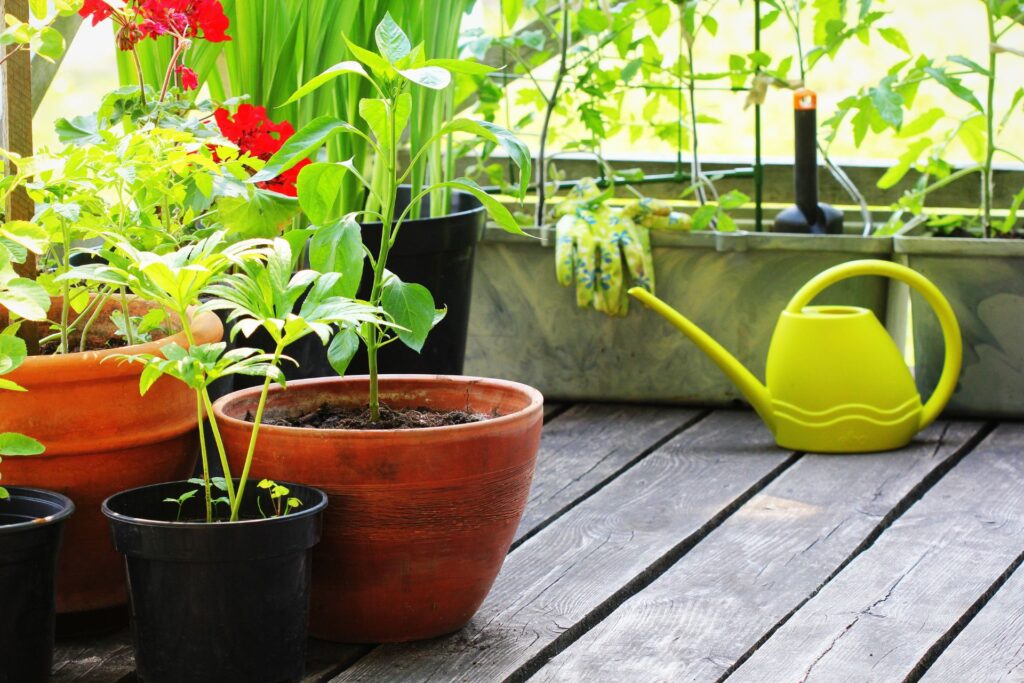
The Best Plants For A Terrace Garden In New Zealand
Creating a vibrant and productive terrace garden in New Zealand can bring joy and a sense of accomplishment. Whether you’re in bustling Auckland or the peaceful stretches of the South Island, understanding the best plants for your terrace is key to gardening success. Here’s a detailed guide to help you select the right plants for your space, covering everything from herbs and flowers to vegetables, fruits, and native plants.
Herbs: Easy-to-Grow Essentials
Herbs are a fantastic addition to any terraced garden due to their easy maintenance and practical uses. Popular choices include:
Parsley: This versatile herb is not only a culinary staple but also thrives in cooler climates, making it ideal for most areas in New Zealand. It requires moderate sunlight and regular watering. Parsley can be used fresh or dried in a wide array of dishes, enhancing flavors beautifully.
Chives: With their mild onion flavor, chives are perfect for adding a punch to salads, soups, and other dishes. They grow well in full sun or partial shade and can be harvested regularly by snipping the leaves at the base.
Mint: Known for its vigorous growth, mint is best contained in pots to prevent it from overtaking other plants. It prefers moist, well-drained soil and partial shade. Mint is perfect for teas, desserts, and garnishing numerous dishes.
Flowers: Color and Resilience
Adding flowers to your terrace garden not only brings color but can also attract beneficial insects. Consider these resilient varieties:
Petunias: These are sun lovers and bloom profusely from spring through fall. Available in a variety of colors, petunias need regular deadheading to keep blooming.
Marigolds: With their bright orange and yellow flowers, marigolds are excellent for repelling pests naturally. They thrive in full sun and well-drained soil, making them easy to grow.
Geraniums: Ideal for container gardening, geraniums need well-drained soil and plenty of sunlight. They offer long-lasting blooms and come in a range of colors, from vibrant reds to soft pinks.
Vegetables: Grow Your Own Food
Terrace gardens are perfect for growing a variety of vegetables, even with limited space. Key vegetable choices include:
Tomatoes: Choose dwarf or bush varieties for terrace gardens. They need at least six hours of sunlight daily and regular watering to produce a fruitful yield.
Lettuce: This cool-season crop can be grown in partial shade and is perfect for successive planting, ensuring a continuous harvest.
Peppers: From sweet to spicy, peppers need warm conditions and plenty of sunlight. Use organic methods like neem oil to manage pests and encourage healthy growth.
Fruits: Compact and Productive
For those looking to add fruit to their terrace gardens, compact varieties make it feasible:
Strawberries: Easy to grow in containers, they require full sun and well-drained soil. Ensure regular feeding during the growing season for a bountiful harvest.
Dwarf Citrus Trees: Varieties like dwarf lemons and limes are suitable for pots and need plenty of sunlight. They not only provide fruit but also add a fragrant aroma to your terrace.
Native Plants: Local Flair and Sustainability
Incorporating native New Zealand plants can enhance the ecological balance of your terrace garden:
Hebe: This native shrub attracts local wildlife and requires minimal care, thriving in various conditions.
Pohutukawa: Known as the New Zealand Christmas tree, it’s perfect for larger terraces and provides spectacular red flowers during the summer.
By choosing the right plants for your New Zealand terrace garden, you can enjoy a lush, productive, and beautiful space. Each plant type offers unique benefits and can thrive with the right care, making your gardening journey both enjoyable and rewarding.
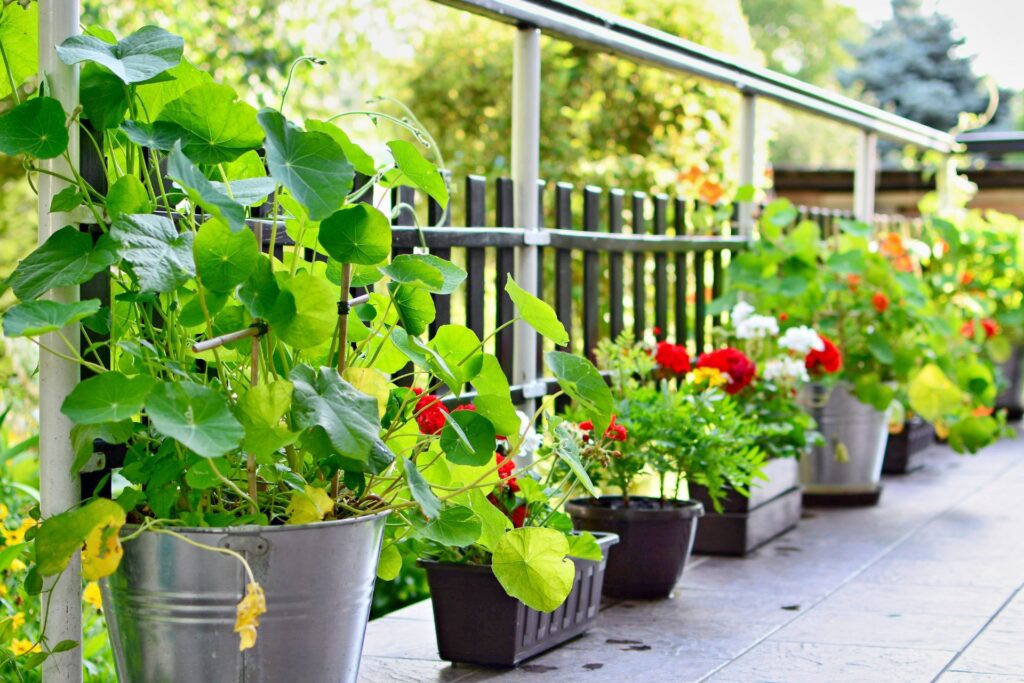
Design Tips For Maximizing Space In Your Terrace Garden
Terrace gardens offer a splendid opportunity to create a serene and vibrant green space, even in urban environments. If you’re looking to maximize the potential of your terrace garden, implementing smart design strategies can transform your compact area into a lush, functional retreat. Here are several effective design tips that help you make the most out of your terrace garden.
1. Embrace Vertical Gardening
Vertical gardening is a fantastic way to use up every inch of space in your terrace garden. By directing the growth of plants upwards, you not only save on floor space but also add visual interest to your garden. Here’s how to do it:
Wall Planters: Install wall planters to turn bland wall surfaces into vibrant green displays. Choose planters that complement the overall aesthetic of your terrace. Opt for a mix of ornamental plants and edible herbs to serve both beauty and functionality.
Railing Planters: Make use of the railings by hanging planters on them. This is not only an excellent way to beautify the barrier, but it also keeps your plants in clear view. Ensure that these planters are securely fastened to withstand windy conditions.
2. Utilize Hanging Baskets
Hanging baskets are a classic solution for adding layers of plants while conserving space. They are particularly suited for small-footprint terraces. Here’s how you can optimize their use:
Choosing Plants: Select plants that naturally drape and spill over the sides of the baskets, such as petunias, ferns, and ivy. These plants create an appealing cascade that enhances the vertical dimension of your garden.
Care Tips: Hanging baskets require regular watering as they tend to dry out faster than ground-level pots. Incorporate a watering routine that keeps the soil moist but not waterlogged. Also, ensure they receive the appropriate amount of sunlight based on the plant type.
3. Select Compact Furniture and Decorative Elements
The choice of furniture and decor can significantly influence the perception of space in your terrace garden. Here’s how to choose wisely:
Furniture: Opt for sleek, compact furniture that fits comfortably in your terrace without overcrowding it. Furniture that can be folded or stacked when not in use is particularly valuable for maximizing space.
Decorative Elements: Incorporate decorative elements that enhance the aesthetics without taking up too much room. Items like small statues, wind chimes, and compact water features can add charm and character to your garden without cluttering it.
Maximizing space in your terrace garden doesn’t require huge investments or extensive renovations. By adopting vertical gardening, utilizing hanging baskets, and selecting appropriate furniture and decorative items, you can create a beautiful and spacious garden oasis atop your city dwelling. These practical tips not only optimize your space but also enhance the overall functionality and appeal of your garden, making your terrace a delightful place to relax and enjoy the outdoors.
Whether you’re an experienced gardener or a beginner, these strategies are easy to implement and can significantly transform your terrace into a more enjoyable and sustainable space.
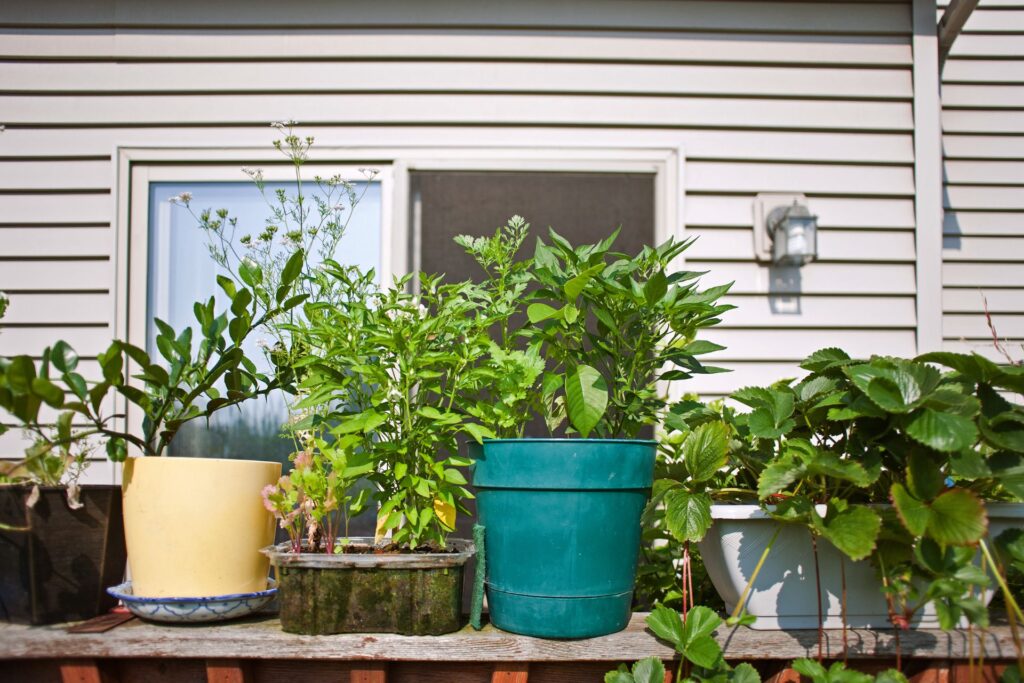
Seasonal Care And Maintenance Tips For Your Garden
Gardening is a rewarding hobby that connects you with nature and provides a beautiful retreat right at your home. To maintain a thriving garden, it’s essential to adjust your care routine with the changing seasons. Each season presents unique challenges and opportunities for gardeners, and adapting to these can lead to a lush, healthy garden year-round. In this guide, we’ll explore seasonal care and maintenance tips to keep your garden in top shape from spring through winter.
Spring: Awakening Your Garden
Spring is a time of renewal and growth, making it crucial to prepare your garden post-winter. Start by clearing out any debris, dead plants, and weeds that have accumulated over the winter months. This cleanup provides a clean slate for new plantings and helps prevent disease and pests.
Next, focus on soil health. Spring is the perfect time to enrich your garden with organic matter. Adding compost or manure will help replenish nutrients depleted over the winter and improve soil structure, which is vital for plant growth. Additionally, test your soil to determine if any specific nutrients are lacking and adjust your fertilization strategy accordingly.
Early pest control is also critical in spring. Inspect your plants regularly for signs of pest activity. Implementing preventative measures such as introducing beneficial insects or applying organic pesticides can help keep pests at bay before they become a significant problem.
Summer: Nurturing Under the Sun
As temperatures rise, maintaining a proper watering regime becomes essential. Water your garden early in the morning or late in the evening to reduce evaporation and ensure that plants receive enough moisture. This timing also helps prevent fungal diseases that can occur when foliage remains wet overnight.
Protecting sensitive plants from the harsh summer sun is also crucial. Consider using shade cloths or planting taller plants strategically to provide natural shade. Additionally, mid-season pruning is beneficial for many plants. It helps remove any dead or diseased branches, encourages air circulation, and promotes healthy growth.
Autumn: Preparing for the Chill
As the growing season winds down, preparing your garden for the colder months ahead is important. Begin by removing any spent plants and harvesting matured crops. This cleanup prevents disease and reduces pest hiding spots.
For plants that are sensitive to cold, consider whether they need to be moved indoors. If you’re bringing plants inside, do so before the first frost to avoid shock. Additionally, autumn is a good time to plant spring-blooming bulbs and perennials that need a cold period before sprouting.
Winter: Safeguarding Against the Cold
Winter care focuses on protection. For outdoor plants, mulching is key. Applying a thick layer of mulch around the base of plants can help insulate roots from freezing temperatures and reduce water loss. Also, consider using burlap or frost cloths to shield sensitive plants from cold winds and frost.
Indoor plant care should not be overlooked during the winter months. Ensure that indoor plants have enough light, as daylight hours are shorter. Keep them away from cold drafts and heating vents, which can dry them out. Regularly check for pests, as indoor environments can sometimes harbor insects like spider mites or scale.
By following these seasonal gardening tips, you can ensure that your garden remains healthy and vibrant throughout the year. Each season requires specific strategies, from revitalizing your soil in spring to protecting plants from the winter chill. With a little planning and effort, you can enjoy a beautiful garden that thrives in all conditions.
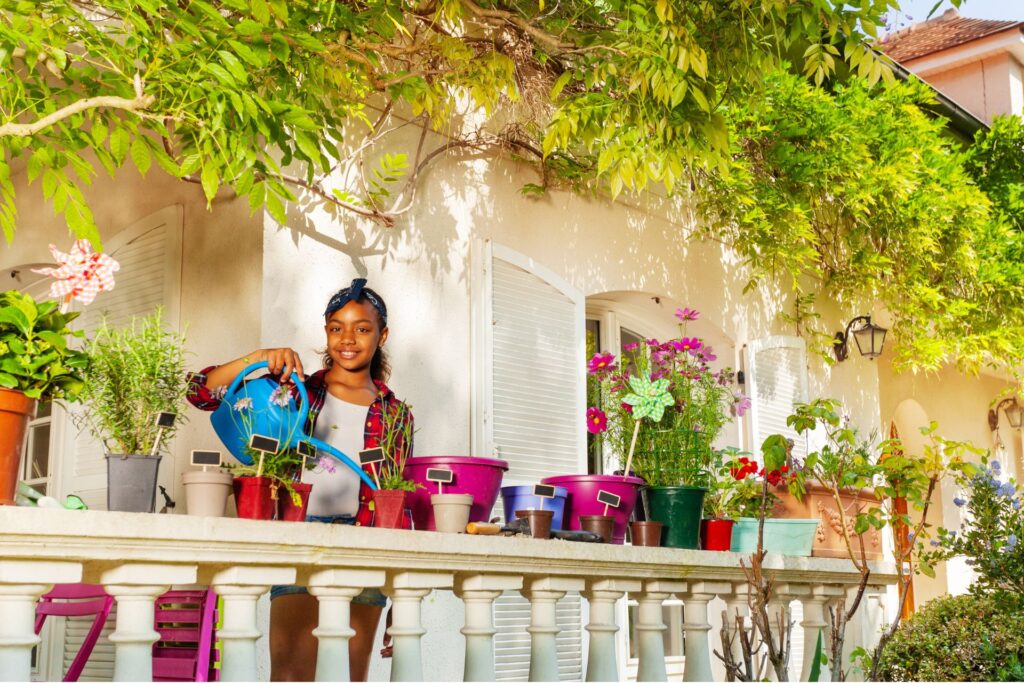
Common Challenges And Solutions In Terrace Gardening
Terrace gardening is an enriching and environmentally friendly way to cultivate plants and vegetables in urban settings. However, it comes with its unique set of challenges. In this article, we delve into the common issues faced by terrace gardeners, particularly focusing on gardening in New Zealand. We provide practical and creative solutions to help you maximize your terrace garden, ensuring it flourishes despite these challenges.
1. Dealing with Limited Space in Terrace Gardens
One of the primary challenges of terrace gardening is the limited space available, especially in urban areas. Here are some creative ideas to effectively utilize space and expand your plant display options:
Vertical Gardening
Utilize vertical spaces by installing hanging planters, wall-mounted pots, and even vertical plant walls. These not only save floor space but also add an aesthetic element to your garden.
Tiered Plant Stands
Implement tiered plant stands which allow you to layer your plants. This can triple the number of plants you display in the same footprint.
Choose Compact Varieties
Opt for plant varieties that are known for their compact growth. Dwarf vegetables and mini herb varieties can thrive in smaller spaces and still yield a good crop.
Utilize Functional Furniture
Consider garden furniture that can double as planters. Bench seats with built-in boxes for plants, or tables with centerpiece planters, can enhance space efficiency.
2. Pest Management in Terrace Gardens
Pests can be a significant issue in any garden, and terrace gardens are no exception. Here are some organic methods to manage common pests in New Zealand:
Neem Oil
An organic pesticide, neem oil is effective against a wide range of pests including aphids, mites, and whiteflies. It’s safe for the environment and does not harm beneficial insects.
Companion Planting
Grow plants that naturally repel pests next to your valuable crops. For example, marigolds can deter beetles and nematodes, while lavender can keep moths and fleas at bay.
Regular Maintenance
Keep your garden tidy and free of debris where pests might breed. Regular pruning and removing weak plants can reduce pest infestations.
Encourage Beneficial Insects
Attract insects like ladybugs, which are natural predators of many common pests. Planting flowers like calendula and cosmos can help draw these beneficial insects to your garden.
3. Managing Weather Challenges in Terrace Gardens
New Zealand’s weather can be unpredictable and can present challenges for terrace gardeners. Here are some tips to protect your plants during unexpected weather changes:
Wind Protection
Use windbreaks such as trellises or temporary netting to protect plants from strong winds, which are common in some parts of New Zealand.
Frost Protection
Invest in frost cloths or grow tunnels to shield your plants during sudden frost. Container plants can be moved to more sheltered locations if needed.
Watering Wisely
Adjust your watering schedule based on the weather. Plants need less water on cloudy or humid days and more during dry spells. Installing a drip irrigation system can ensure your plants get the right amount of water without wastage.
Choose Hardy Plants
Opt for plants known to be resilient to weather changes. Native New Zealand plants are often well-adapted to local conditions and can be more robust against weather fluctuations.
Terrace gardening in New Zealand can be immensely rewarding, providing a lush, green retreat in urban settings. By creatively using space, implementing organic pest management strategies, and preparing for weather challenges, you can ensure your garden not only survives but thrives. Whether you’re a seasoned gardener or a beginner, these tips can help you overcome the challenges of terrace gardening and enjoy the fruits (and vegetables!) of your labor.
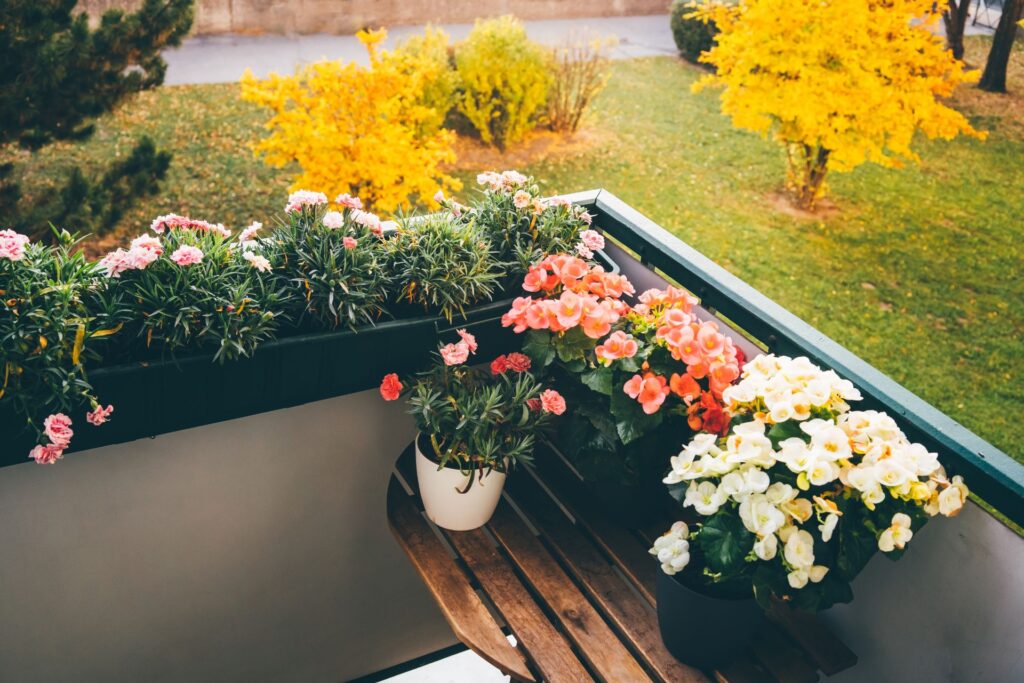
Inspirational Case Studies
When exploring the marvels of urban gardening, the terrace gardens in New Zealand present a perfect tableau of greenery, sustainability, and personal accomplishment. This section delves into several inspirational case studies of successful terrace gardens flourishing within the bustling urban settings of New Zealand. Through these examples, we uncover not only the beauty and productivity of such gardens but also gather practical insights directly from the garden owners.
The Essence of Terrace Gardening in Urban Settings
Terrace gardens are becoming increasingly popular in urban areas where ground space is limited but the desire to connect with nature remains high. These gardens utilize the flat roofs or terraces of buildings, transforming them into vibrant spaces of flora that provide fresh produce, a place to unwind, and a habitat for urban wildlife. In cities across New Zealand, from Auckland to Christchurch, residents are turning their rooftops into lush gardens as a way to combat the concrete jungle’s drabness.
Case Study 1: The Urban Oasis in Auckland
In Auckland, a sprawling terrace garden sits atop a high-rise, offering panoramic views of the city skyline. The owner, Emily, transformed her 200-square-meter terrace into a thriving garden with a mix of vegetables, herbs, and flowering plants. “It’s about using every inch of space you have,” Emily shares. She uses raised beds and container planting to maximize her growing area, a technique that could be emulated by urban dwellers anywhere.
Emily’s garden not only provides her family with fresh produce year-round but also serves as a peaceful retreat from urban life. Her tip for aspiring gardeners is to start small. “Choose easy-to-grow vegetables like lettuce, spinach, and tomatoes, and you’ll see how rewarding it is to grow your own food,” she advises.
Case Study 2: The Culinary Haven in Wellington
Further south in Wellington, Mark has turned his rooftop into a culinary haven. As a chef, fresh ingredients are paramount, and what could be fresher than picking them from your roof? Mark’s garden includes a variety of herbs, edible flowers, and specialty vegetables, which he uses in his restaurant.
“The connection between the kitchen and the garden is vital,” says Mark. His garden not only impacts his cooking style but also inspires his menu, emphasizing seasonal and local ingredients. He integrates water-saving irrigation systems and composting to enhance sustainability. Mark encourages urban gardeners to experiment with different plant types. “It’s amazing how much you can grow in a small space with some creativity and care,” he remarks.
Learning from Experience: Tips from Urban Gardeners
Both case studies highlight important tips and experiences shared by the garden owners:
Start Small: Begin with easy-to-manage plants and gradually expand your garden as you gain more confidence and experience.
Maximize Space: Use raised beds, vertical gardening techniques, and container gardening to make the most of limited space.
Sustainability Practices: Implement eco-friendly practices such as rainwater harvesting, composting, and efficient watering systems to reduce your environmental footprint.
Experiment: Don’t be afraid to try growing different types of plants, which can be both a learning experience and a way to discover what works best in your unique garden environment.
By incorporating these insights and inspirations from Emily and Mark, anyone can embark on their journey to create a vibrant and productive terrace garden in an urban setting. The benefits extend beyond just fresh produce—these gardens can become a sanctuary for biodiversity and a testament to sustainable living practices in city environments.
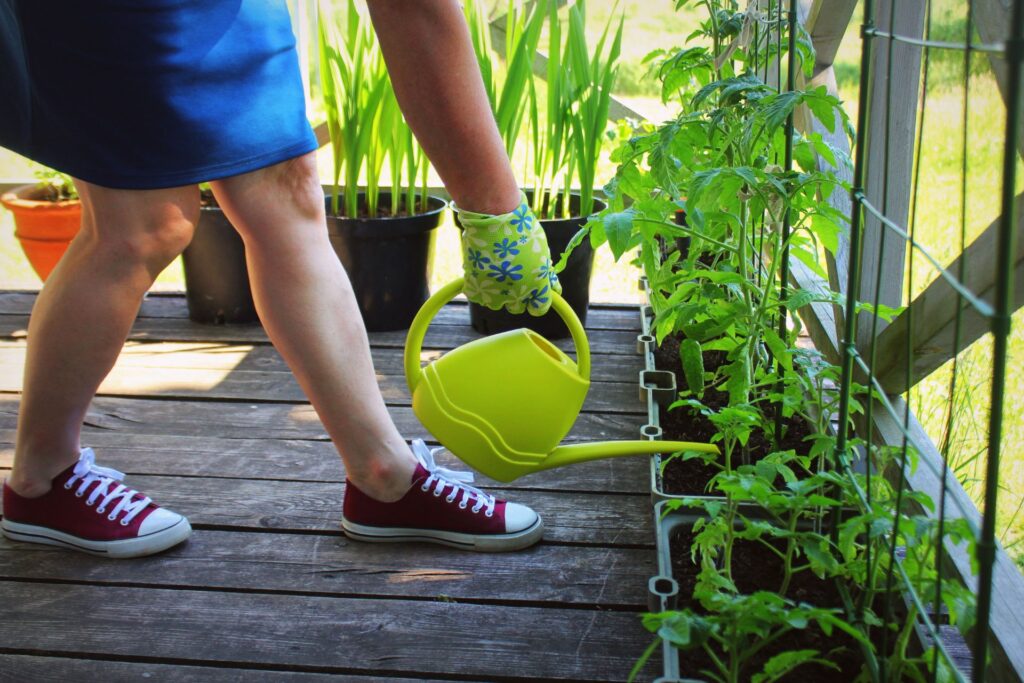
FAQs: About Best Plants For Terrace Garden NZ
Conclusion
Terrace gardening offers a multitude of joys and benefits, transforming urban spaces into vibrant, green sanctuaries ideal for relaxation and reconnecting with nature. It allows enthusiasts of all levels to cultivate fresh produce right at home, promoting a healthier lifestyle and reducing environmental impact. Starting simple with herbs and easy-to-grow vegetables, gardeners can gradually expand their knowledge and garden complexity. This form of gardening isn’t just about nurturing plants but also about fostering creativity, alleviating stress, and building community through shared green spaces. Whether you’re a novice or an experienced gardener, terrace gardening is a rewarding journey that enhances both personal and environmental well-being, inviting you to savor each step from seed to harvest.




